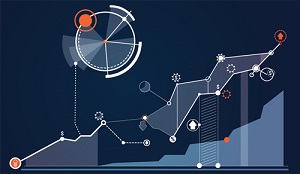It is important to have the right tools and solutions underpinning your analytics endeavors. After all, technology is at the heart of every stage of analytics work, from data ingestion to execution and visualization. And the advancements made in recent years have been tremendous. Which begs the question, what will the analytics tech of tomorrow look like?
The analytics tech space is one that is ever evolving, but two main things are occurring in the space at the minute, and it’s all about speed to insight. The first is that people are trying to make sure data is available in almost real-time across the business. This takes a lot of processing power and investment in infrastructure, but it’s a major focus at the minute and one that can pay huge dividends.
Second, once this data is ingested, people want to make it faster to process. The ultimate goal is gaining insights in as close to real-time as possible, and that’s becoming increasingly feasible.
A great example of what you can do when you can ingest and analyze data at speed is in sports. If you’re having TV issues and you can no longer watch the game, you might go on YouTube to look for live scores instead. Now, you can find a video with the live score and animated characters reflecting the players on the field and their precise movements. It’s a complete recreation of the game; the players had the same playing style as in real life, and the ball took the same trajectory—and it was only ever one or two balls behind the live-action.
Besides a heightened focus on the speed of insight, one prominent trend that is beginning to find its feet in the space is edge computing. To explain, if you have a smartwatch that performs calculations about your heart rate and how many calories you burn etc., this is a basic example of edge computing. It’s essentially all about computing at the storage level within the device itself—this is all about accelerating time to insight. We’re now seeing companies deploying algorithms within devices, like cameras used for computer vision, so that they can deliver results with hardly any latency at all.
For those watching the analytics tech space closely, it’s worth keeping an eye on blockchain. Blockchain could have a huge role to play going forward. At a concept level, blockchain is about creating a decentralized database where whatever has been written can’t be edited. In that sense, it’s a very secure database mechanism that provides many advantages to companies that need to ensure data sanctity is maintained. Think financial institutions, for instance.
The most obvious example of blockchain, and the thing people often associate it with, is cryptocurrency, but there are endless possible applications. For instance, we’ve recently seen Walmart integrate blockchain into its supply chain, so it can track every touchpoint a product goes through before it arrives in our home.
Because this data is tamper-proof, it’s easy for Walmart to trace the provenance of any issues that occur and resolve them before they have a significant impact on the rest of the stock. This would have been impossible five or ten years ago.
As we look to the future of analytics tech, we can be confident that speed will be at the forefront. Companies have mastered the ability to collect data, and now they are looking for faster solutions to processing that data. Despite what new tech arises in the space, technology will remain at the heart of every stage of analytics work.
About the Author

Nitin Aggarwal, Vice President of Analytics and Data Science for The Smart Cube. Nitin is an analytics executive and a seasoned business leader with 15+ years of experience across industries and functions. Based out of The Smart Cube’s Chicago office, Nitin leads the Retail, CPG & Consumer Markets practice in the US. Prior to this role, Nitin developed and scaled the data analytics practice, and managed operations across the globe. He also drove the practice strategy in terms of new capabilities, solutions, and technologies from India. Nitin studied electrical engineering at Punjab Engineering College, Chandigarh, MBA at University of Notre Dame, and got his Executive education in Analytics from SDA Bocconi.
Sign up for the free insideBIGDATA newsletter.
Join us on Twitter: https://twitter.com/InsideBigData1
Join us on LinkedIn: https://www.linkedin.com/company/insidebigdata/
Join us on Facebook: https://www.facebook.com/insideBIGDATANOW





Thank you, Nitin, for providing such an informative blog, in my opinion, I’m personally bullish on blockchain technology and would love to see how govt. will accept Web 3 technology in the next 5-10 years.